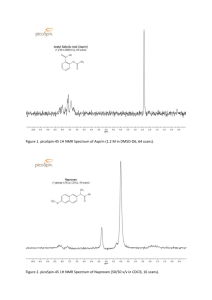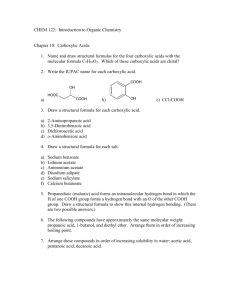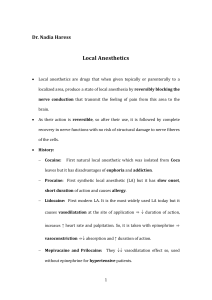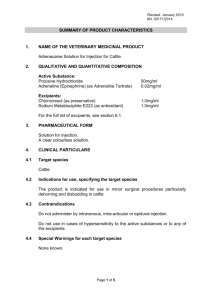noditi g - Revista de Chimie
advertisement
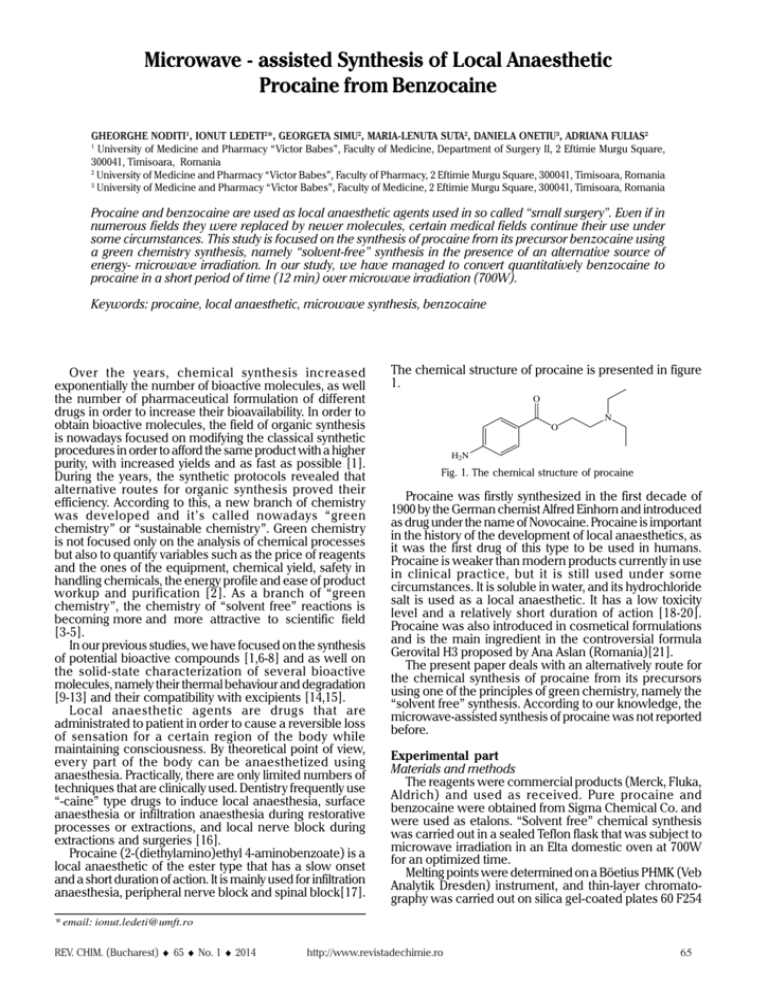
Microwave - assisted Synthesis of Local Anaesthetic Procaine from Benzocaine GHEORGHE NODITI1, IONUT LEDETI2*, GEORGETA SIMU2, MARIA-LENUTA SUTA2, DANIELA ONETIU3, ADRIANA FULIAS2 1 University of Medicine and Pharmacy “Victor Babes”, Faculty of Medicine, Department of Surgery II, 2 Eftimie Murgu Square, 300041, Timisoara, Romania 2 University of Medicine and Pharmacy “Victor Babes”, Faculty of Pharmacy, 2 Eftimie Murgu Square, 300041, Timisoara, Romania 3 University of Medicine and Pharmacy “Victor Babes”, Faculty of Medicine, 2 Eftimie Murgu Square, 300041, Timisoara, Romania Procaine and benzocaine are used as local anaesthetic agents used in so called “small surgery”. Even if in numerous fields they were replaced by newer molecules, certain medical fields continue their use under some circumstances. This study is focused on the synthesis of procaine from its precursor benzocaine using a green chemistry synthesis, namely “solvent-free” synthesis in the presence of an alternative source of energy- microwave irradiation. In our study, we have managed to convert quantitatively benzocaine to procaine in a short period of time (12 min) over microwave irradiation (700W). Keywords: procaine, local anaesthetic, microwave synthesis, benzocaine Over the years, chemical synthesis increased exponentially the number of bioactive molecules, as well the number of pharmaceutical formulation of different drugs in order to increase their bioavailability. In order to obtain bioactive molecules, the field of organic synthesis is nowadays focused on modifying the classical synthetic procedures in order to afford the same product with a higher purity, with increased yields and as fast as possible [1]. During the years, the synthetic protocols revealed that alternative routes for organic synthesis proved their efficiency. According to this, a new branch of chemistry was developed and it’s called nowadays “green chemistry” or “sustainable chemistry”. Green chemistry is not focused only on the analysis of chemical processes but also to quantify variables such as the price of reagents and the ones of the equipment, chemical yield, safety in handling chemicals, the energy profile and ease of product workup and purification [2]. As a branch of “green chemistry”, the chemistry of “solvent free” reactions is becoming more and more attractive to scientific field [3-5]. In our previous studies, we have focused on the synthesis of potential bioactive compounds [1,6-8] and as well on the solid-state characterization of several bioactive molecules, namely their thermal behaviour and degradation [9-13] and their compatibility with excipients [14,15]. Local anaesthetic agents are drugs that are administrated to patient in order to cause a reversible loss of sensation for a certain region of the body while maintaining consciousness. By theoretical point of view, ever y part of the body can be anaesthetized using anaesthesia. Practically, there are only limited numbers of techniques that are clinically used. Dentistry frequently use “-caine” type drugs to induce local anaesthesia, surface anaesthesia or infiltration anaesthesia during restorative processes or extractions, and local nerve block during extractions and surgeries [16]. Procaine (2-(diethylamino)ethyl 4-aminobenzoate) is a local anaesthetic of the ester type that has a slow onset and a short duration of action. It is mainly used for infiltration anaesthesia, peripheral nerve block and spinal block[17]. The chemical structure of procaine is presented in figure 1. O O N H2N Fig. 1. The chemical structure of procaine Procaine was firstly synthesized in the first decade of 1900 by the German chemist Alfred Einhorn and introduced as drug under the name of Novocaine. Procaine is important in the history of the development of local anaesthetics, as it was the first drug of this type to be used in humans. Procaine is weaker than modern products currently in use in clinical practice, but it is still used under some circumstances. It is soluble in water, and its hydrochloride salt is used as a local anaesthetic. It has a low toxicity level and a relatively short duration of action [18-20]. Procaine was also introduced in cosmetical formulations and is the main ingredient in the controversial formula Gerovital H3 proposed by Ana Aslan (Romania)[21]. The present paper deals with an alternatively route for the chemical synthesis of procaine from its precursors using one of the principles of green chemistry, namely the “solvent free” synthesis. According to our knowledge, the microwave-assisted synthesis of procaine was not reported before. Experimental part Materials and methods The reagents were commercial products (Merck, Fluka, Aldrich) and used as received. Pure procaine and benzocaine were obtained from Sigma Chemical Co. and were used as etalons. “Solvent free” chemical synthesis was carried out in a sealed Teflon flask that was subject to microwave irradiation in an Elta domestic oven at 700W for an optimized time. Melting points were determined on a Böetius PHMK (Veb Analytik Dresden) instrument, and thin-layer chromatography was carried out on silica gel-coated plates 60 F254 * email: ionut.ledeti@umft.ro REV. CHIM. (Bucharest) ♦ 65 ♦ No. 1 ♦ 2014 http://www.revistadechimie.ro 65 O N HO O (2) O H2N Ethyl 4-aminobenzoate (Benzocaine) (1) EtONa / M.W. 700 W, time -EtOH O N Scheme 1. Synthetic protocol for obtaining the procaine H2N 2-(diethylamino)ethyl 4-aminobenzoate (Procaine) (3) Table 1 THE ADVANCE OF REACTION MONITORED BY TLC Merck using hexane:ethyl acetate 1:1 (v/v) as eluent. Chromatographic spots were revealed under UV light (ε=254 nm) followed by the subjection of the TLC plates in iodine vapours. IR spectra were recorded for a dispersion of the substance in KBr pellets (Specac Pellet Press) on a Jasco FT/IR-410 spectrophotometer, with a resolution of 1 cm-1 on 400 cm-1 – 4000 cm-1 spectral range. Spectra were built up after a number of 16 acquisitions. Microwave-assisted synthesis of procaine A suspension of ethyl 4-aminobenzoate (benzocaine) (1.651g, 0.01 mol) in 2-(diethylamino)ethanol (1.33 mL, 1.172g, 0.01 mol) and EtONa (0.68g, 0.01 mol) was placed in a glass flask with a capacity of 5 mL. The mixture was manually homogenized, then placed inside a sealed Teflon flask and subject gradually (1-12 min) to 700W microwave (MW) irradiation. The advance of reaction was monitored by the use of thin layer chromatography (TLC). The brute procaine was obtained as a viscous liquid that solidifies at room temperature. The solid was suspended in 10 mL of distilled water, heated at 80°C, purified with active charcoal and filtered while hot under reduced pressure. After cooling at room temperature, pure procaine precipitates as white crystals, then filtered under reduced pressure and dried at 40°C for 4h. Results and discussions The synthetic protocol followed in order to obtain 2(diethylamino)ethyl 4-aminobenzoate (3) by the reaction of ethyl 4-aminobenzoate (1) with 2-(diethylamino)ethanol (2) in the presence of sodium ethoxide (EtONa) under microwave irradiation is presented in scheme 1. This synthetic protocol was adapted after a well-known procedure previously described in literature [22]. In order to avoid the use of solvents (volatile organic compounds, VOC) for carrying this synthesis and to reduce the reflux time necessary for obtaining procaine from benzocaine with the use of solvent, we set our goal in the microwave-assisted synthesis without any use of solvent. Due to the fact that the necessary time for the complete synthesis is unknown, a gradually irradiation of the mixture took place in a period of 12 min. The advance of the reaction was monitored by TLC, and the results are presented in table 1. The aspect of the TLC plate for pure compounds is presented in figure 2, as well for the reaction mixtures at different intervals of irradiation. By the analysis of the TLC plate for pure compounds (A)-(D), one can notice that in these experimental conditions, the spots corresponding to benzocaine and procaine are different, due to the fact that the interaction of these compounds with stationary phase is different. Due to the fact that the mixture of eluents (hexane and ethyl acetate) possess a decreased polarity, the spot corresponding to benzocaine has an higher Rf (~0.61) that the one corresponding to more polar procaine (Rf ~0.47). The low-polarity mobile phase is unable to eluate a higly polar compound such as sodium ethoxide, so the spot remains in start (Rf = 0.00). As well, TLC does not reveal under these experimental conditions a chromatographic spot for 2-(diethylamino)ethanol. The analysis of the reaction mixture revealed that in the first 5 min of MW irradiation, no interaction between reagents occur, namely no TLC spot for procaine is observed. By increasing the time of irradiation, a new chromatographic spot appears, corresponding to procaine (time 6-11 min). After 12 min of microwave irradiation, one can notice the a complete disappearance of benzocaine, due to the formation of procaine. In order to obtain pure procaine, the reaction mixture was purified by recrystallization from hot water, as previously mentioned. The characteristics of obtained procaine are presented as follows: Fig.2. TLC plate for pure reagents: (A)-sodium ethoxide; (B)-benzocaine; (C)-procaine; (D)-2-(diethylamino)ethanol, and for reaction mixture at different intervals of time 66 http://www.revistadechimie.ro REV. CHIM. (Bucharest) ♦ 65♦ No.1 ♦ 2014 1 Fig. 3. Comparative FTIR spectra of starting material (Benzocaine) and product (Procaine) 2 1 2 1 Fig. 4. Comparative FTIR spectra of standard Procaine (Sigma Chemical Co.) and the one obtained by synthesis from benzocaine under MW irradiation 2 1 2 Procaine (2-(diethylamino)ethyl 4-aminobenzoate) (3) White crystals (2.04g, yield 86%) M.p. 61 – 62 °C (61 °C [11]) IR (KBr, cm-1): 3424, 3343, 3222, 2977, 2954, 2896, 1683 (C=O), 1635, 1598, 1513, 1311, 1282, 1172, 1128, 1022, 846, 773, 700, 615, 505. FTIR spectroscopy was used for characterization of both benzocaine (as starting material) and procaine. The comparative FTIR spectra for pure benzocaine (which is the starting material) and pure procaine are presented in figure 3. As a further proof for the formation of procaine via microwave irradiation, comparative FTIR spectra were drawn up both for pure procaine and the one obtained and purified by us (fig.4.). By the analysis of the FTIR spectra from figure 4., one can notice that the obtained substances are identical from spectroscopic point of view. This confirms that our synthetic pathway is a simplified and efficient method for the synthesis of procaine from benzocaine. Conclusions Corroborating the information obtained by FTIR spectroscopy with the one obtained from thin layer chromatography, it can be said that the use of microwave energy is an improved route for the synthesis of procaine from benzocaine in a so-called “solvent-free” synthesis. According to this procedure, the reaction time was reduced to 12 min and the synthesis was carried out without any use of volatile organic compounds (VOC). The purification of crude procaine was realized solely by the use of distilled water, which is a cheap and an non-polluting solvent. References 1.LEDETI, I.V., BERCEAN, V.N., TANASE, I.M., CREANGA, A.A., BADEA, V., CSUNDERLIK, C., Rev. Chim. (Bucharest), 61, no. 10, 2010, p. 935. 2.VAN AKEN, K., STREKOWSKI, L., PATINY, L., BEILSTEIN, J. Org. Chem., 2, 2006, p.3. 3.PEROZO-RONDON, E., MARTÍN-ARANDA, R.M., CASAL, B., DURANVALLE, C.J., LAU, W.N., ZHANG, X.F., YEUNG, K.L., Catal. Today, 114, 2006, p. 183. 4.PALLEROS, D.R., J. Chem. Educ., 81, 2004, p. 1345 REV. CHIM. (Bucharest) ♦ 65 ♦ No. 1 ♦ 2014 5.NEMATI, F., BEYZAI, A., J. Chem., 2013, doi:10.1155/2013/365281, Article ID 365281 6.LEDETI, I.V., BERCEAN, V.N., BADEA ,V., BALAN, M., CSUNDERLIK, C., Rev. Chim. (Bucharest), 61, no. 9, 2010, p. 833 7.BERCEAN, V.N., LEDETI, I.V., BADEA ,V., BALAN, M., CSUNDERLIK, C., Rev. Chim. (Bucharest), 61, no. 11, 2010, p. 1028 8.LEDETI, I., SIMU, G., VLASE, G., SAVOIU, G., VLASE, T., SUTA, L.-M., POPOIU, C., FULIAS, A., Rev. Chim. (Bucharest), 64, no. 10, 2013, p. 1127. 9.LEDETI, I., FULIAS, A., VLASE, G., VLASE, T., BERCEAN, V., DOCA, N., J. Therm. Anal. Calorim. 114, 2013, p. 1295. 10.FULIAS, A., BOBRIC, A., VLASE, G., VLASE, T., DOCA, N., Rev. Roum. Chim., 56(10-11), 2011, p. 959. 11.FULIAS, A., VLASE, G., GRIGORIE, C., LEDETI, I., ALBU, P., BILANIN, M., VLASE, T., J. Therm. Anal. Calorim., 113(1), 2013, p. 265. 12.FULIAS, A., VLASE, G., VLASE, T., SOICA, C., HEGHES, A., CRAINA, M., LEDETI, I., Chem. Cent. J., 7, 2013, article number 70. 13.ANGHEL, M., VLASE, G., BILANIN, M., VLASE, T., ALBU, P., FULIAS, A., TOLAN, I., DOCA, N., J. Therm. Anal. Calorim., 113(3), 2013, p. 1379. 14.FULIAS, A., LEDETI, I., VLASE, G., VLASE, T., J. Pharmaceut. Biomed., 81–82, 2013, p. 44. 15.FULIAS, A., VLASE, T., VLASE, G., DOCA, N., J. Therm. Anal. Cal., 99, 2010, p. 987. 16.MOORE, P.A., HERSH, E.V., Dent. Clin. North. Am., 54(4), 2010, p. 587. 17.REYNOLDS, J.E.F., Martindale, The Extra Pharmacopoeia, 30th edition, Pharmaceutical Press., 1993, London, p. 1016. 18.SATILMIS, T., GONUL, O., GARIP, H., GOKER, K., A New and Enhanced Version of Local Anesthetics in Dentistry, Clinical Use of Local Anesthetics, Dr. Asadolah Saadatniaki (Ed.), InTech, 2012, Available from: http://www.intechopen.com/books/clinical-use-oflocal-anesthetics/a-new-and-enhanced-version-of-local-anesthetics-indentistry 19.MILAM, S.B., GIOVANNITTI, J.A.Jr., Dent. Clin. North. Am., 28(3), 1984, p. 493. 20.SZABO, G., Oral and Maxillofacial Surgery, Semmelweis Publishing House. Budapest, 2001, p. 20–34. 21.OSTFELD, A., SMITH, C.M., STOTSKY, B.A., J. Am. Geriatr. Soc., 25(1), 1977, p.1. 22.DE RUBEN, V., HRUBY, V., Synthesis of Essential Drugs, Elsevier, 2006, Amsterdam, p.12 Manuscript received:11.12.2013 http://www.revistadechimie.ro 67 10 http://www.revistadechimie.ro REV. CHIM. (Bucharest) ♦ 65♦ No.1 ♦ 2014 REV. CHIM. (Bucharest) ♦ 65 ♦ No. 1 ♦ 2014 http://www.revistadechimie.ro 11 12 http://www.revistadechimie.ro REV. CHIM. (Bucharest) ♦ 65♦ No.1 ♦ 2014
